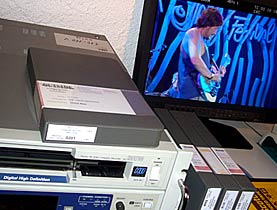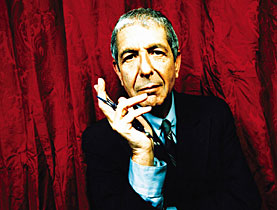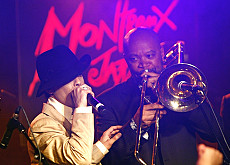Sounds of Montreux linger on

The 2008 Montreux Jazz Festival is over, but its music, along with memories from over four decades, lives on in the "Live at Montreux" DVDs and CDs.
Since 1967, the festival’s founder and director, Claude Nobs has tried to keep a record of the music. His partner, Thierry Amsalem, now looks after the archive stored in Nobs’ chalet in the hills above Lake Geneva and managed by the Montreux Sounds company.
It was there that swissinfo visited Amsalem to see and hear some of the treasures collected over the past four decades.
swissinfo: The idea of releasing recordings from the festival is nothing new – they been issued since the end of the 1960s.
Thierry Amsalem: In 1969, the McCanns published a record of their concert in Montreux under the name “Swiss Movement”, and it sold a million copies. That was instrumental in launching the idea that the artist should always have the possibility of taking their tapes and publishing them.
swissinfo: But Montreux Sounds was only established in 1995.
T.A.: Strangely enough, before that the Montreux tourist office ran the festival. They organised the TV symposium – the Golden Rose – and the festival. But these were financially risky events, and they finally went bankrupt. So in 1995 the festival was taken over by a foundation and we bought the archives through Montreux Sounds.
I met Claude 22 years ago and he gave me the job of collecting together all the tapes that had been scattered far and wide. Radio stations had some of them, record companies as well as private individuals had others, and even Claude had a few. It took me five years to collect the whole lot.
The festival bankruptcy didn’t happen until much later. So we decided then to buy all these documents. It might be a cultural goldmine, but you still have to know how to save and manage them and something Claude Nobs can handle.
swissinfo: How many hours of film are stored here today?
T.A.: About 6,000, spread over 10,000 tapes. Tapes, because the sound is recorded separately, on multi-track, which means you can correct it or work on it later.
swissinfo: Which artists are missing from your archives?
T.A.: Claude dreams of having the Rolling Stones. But each time he meets them, Mick Jagger says: ‘But Claude, you know I don’t play jazz!’ And each time we bring him DVDs to show him that dozens of rock artists have performed at Montreux!
swissinfo: The big problem for anyone storing archives – print, sound or video – is conservation, transferring data from one support medium to another. You are about to start digitalising the whole lot.
T.A.: In September we’re going to take a major step, which is now technically possible: put it all on to computer files. But the system’s storage capacity will be 1.2 petabytes, or 1.2 million gigabytes. That’s equivalent to 12,000 average home computers!
We had to find the money to get started, since we don’t have any state backing. The Federal Institute of Technology in Lausanne is involved in the project on the technical side. As part of it, it is going to create audio-visual departments. At the moment all television stations have the same problem that we do. The institute is going to work on everything to do with storage, security, data transport and transfers.
swissinfo: How do you choose what you are going to publish?
T.A.: We have to talk to the artists: we have the tape, but the musician holds the artistic rights. At the moment we are in a very favourable situation because the record market has collapsed. It used to be that the concert helped promote an album that had just come out, but now it’s the opposite: the recording helps promote concerts.
swissinfo: Do you ever have artists who say no?
T.A.: Very rarely. But that happened with Prince, for example. His religion [he is now a Jehovah’s Witness] forbids him from being photographed or filmed. So we could only record the sound of his concert.
swissinfo: What are your long-term projects?
T.A.: To work with universities and museums. We are for example in contact with Paul Allen, one of the founders of Microsoft, who has a music museum in Seattle which doesn’t have very much in it so far. We hope we can show our collection there once it is completely digitalised.
swissinfo, Bernard Léchot in Caux
The 42nd Montreux Jazz Festival ended on a satisfactory note for the organisers, who announced that the cost of staging the event had been covered for the second straight year. The budget this year was over SFr18 million ($17.6 million).
The festival’s secretary-general Mathieu Jaton said that 87,000 tickets were sold for the concerts held over a two-week period, and that cost-cutting measures such as no longer using the casino for concerts had been effective.
More than 330 groups and musicians played during the festival, including 209 that gave free concerts.
Next year’s festival will take place from July 3 through to July 18.
– James Brown 1981
– Canned Heat 1973
– Johnny Cash 1994
– Ray Charles 1997
– Chic with Nile Rodgers 2004
– The Complete Miles Davis At Montreux: 1973-1991
– Deep Purple, 1996 and 2006
– Rory Gallagher, The Definitive Collection: 1975-1994
– Marvin Gaye 1980
– Johnny Hallyday 1988
– Charles Mingus 1975
– Nina Simone 1976
– Weather Report 1976
– Yes 2003

In compliance with the JTI standards
More: SWI swissinfo.ch certified by the Journalism Trust Initiative










You can find an overview of ongoing debates with our journalists here . Please join us!
If you want to start a conversation about a topic raised in this article or want to report factual errors, email us at english@swissinfo.ch.